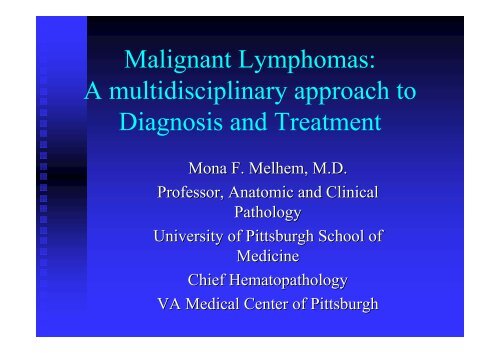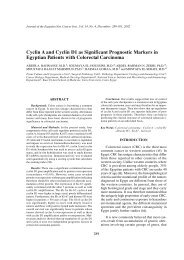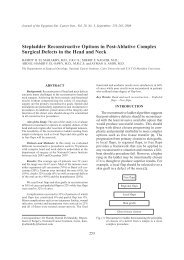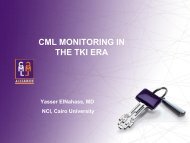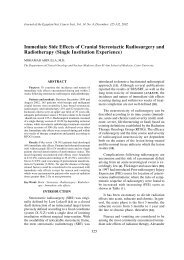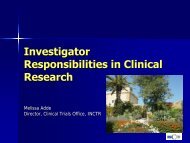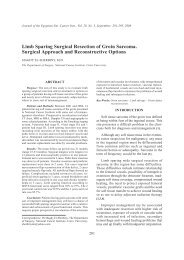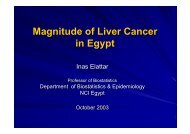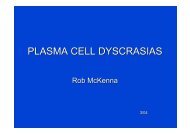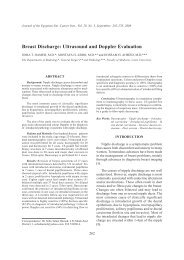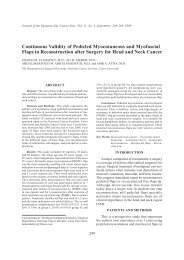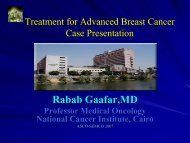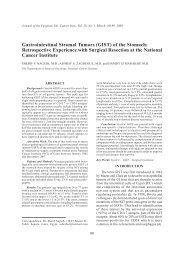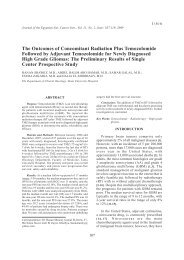Malignant Lymphomas: A multidisciplinary approach to ... - NCI
Malignant Lymphomas: A multidisciplinary approach to ... - NCI
Malignant Lymphomas: A multidisciplinary approach to ... - NCI
Create successful ePaper yourself
Turn your PDF publications into a flip-book with our unique Google optimized e-Paper software.
<strong>Malignant</strong> <strong>Lymphomas</strong>:<br />
A <strong>multidisciplinary</strong> <strong>approach</strong> <strong>to</strong><br />
Diagnosis and Treatment<br />
Mona F. Melhem, M.D.<br />
Professor, Ana<strong>to</strong>mic and Clinical<br />
Pathology<br />
University of Pittsburgh School of<br />
Medicine<br />
Chief Hema<strong>to</strong>pathology<br />
VA Medical Center of Pittsburgh
Tool for accurate diagnosis of<br />
lymphoproliferative disorders<br />
�� His<strong>to</strong>logy (H&E)<br />
�� Immunohis<strong>to</strong>chemistry<br />
�� Flowcy<strong>to</strong>metry<br />
�� Cy<strong>to</strong>genetic<br />
�� Chromosome analysis<br />
�� FISH and Chromosome paintings<br />
�� Molecular Pathology<br />
�� Laser Capture Microscopy
Newer treatment modalities<br />
�� Principles of Immunotherapy<br />
�� Development of new generation of drugs<br />
�� Rituximab, Rituximab,<br />
the new champion
Lymphoproliferative disorders<br />
�� Clonal proliferation of lymphocytes at<br />
different stages of differentiation<br />
�� They include T-cell, T cell, B-cell B cell and Natural<br />
killer cell neoplasms. neoplasms<br />
�� Recapitulates stages of normal lymphocyte<br />
differentiation<br />
�� 4% of new cancers each year<br />
�� Incidence: 15/100,000
Frequency of B and T/NK cell lymphomas<br />
�� Diffuse large B-cell B cell 30.6%<br />
�� Follicular 22.1%<br />
�� MALT 7.6%<br />
�� Mature T-cell T cell 7.6%<br />
�� CLL/SLL 6.7%<br />
�� Mantle cell 6.0%<br />
�� Mediastinal large B-cell B cell 2.4%<br />
�� Anaplastic large cell 2.4%<br />
�� Burkitt’s 2.5%<br />
�� Marginal zone 1.8%<br />
�� Precursor T lymphoblastic 1.7%<br />
�� Lymphoplasmacytic 1.2%<br />
�� Others 7.4%
WHO His<strong>to</strong>logic Classification<br />
of B-cell Neoplasms<br />
�� Precursor B lymphoblastic leukemia/lymphoma<br />
�� CLL/Small lymphocytic lymphoma<br />
�� Lymphoplasmacytic lymphoma<br />
�� Marginal Zone Lymphoma (splenic ( splenic and MALT)<br />
�� Follicular Lymphoma<br />
�� Mantle cell Lymphoma<br />
�� Primary effusion lymphoma<br />
�� Burkitt’s Lymphoma
Etiology<br />
�� Epstein Barr virus in Burkitt’s lymphoma<br />
�� Human Herpesvirus-8/<br />
Herpesvirus 8/ Kaposi sarcoma<br />
virus in primary effusion lymphoma<br />
�� Hepatitis C virus in lymphoplasmacytic<br />
lymphoma<br />
�� Helicobacter Pylori in gastric MALT<br />
lymphomas
Cell Markers<br />
�� As normal lymphocytes mature, they gain<br />
and/or loose certain surface, cy<strong>to</strong>plasmic or<br />
nuclear markers that distinguish every stage<br />
of development.<br />
�� These markers are important and are used in<br />
the diagnosis, and later specific treatment of<br />
specific neoplasms. neoplasms.
Immunohis<strong>to</strong>chemistry<br />
�� The “poor man” immunophenotyping<br />
�� Can use<br />
�� paraffin-embedded paraffin embedded (archival)<br />
�� frozen tissues<br />
�� 5 micron section slides<br />
�� Monoclonal vs. polyclonal antibodies
Intestinal Biopsy: D. Dx.<br />
�� Reactive Hyperplasia (? H Pylori)<br />
�� Follicular lymphoma (Grades 1&2 indolent,<br />
Grade3 aggressive, likelihood for relapse)<br />
�� 25-35% 25 35% progress <strong>to</strong> DLBCL<br />
�� Mantle cell Lymphoma<br />
�� More aggressive (3-5 (3 5 yr survival), PB involved<br />
�� Marginal zone B-cell B cell lymphoma of mucosa<br />
associated lymphoid tissues (MALT)<br />
�� Indolent natural course, slow disseminatio,<br />
disseminatio,<br />
radiation sensitive, prolonged remission,<br />
respond <strong>to</strong> H pylori & Broad spectrum Ab ttt
Intestinal Biopsy: D DX<br />
� Reactive hyperplasia:<br />
� CD20+, CD3+, CD21+, BCL-2-, CD10-<br />
� Follicular Lymphoma<br />
� CD20+, CD3-, CD10+, BCL-2+, CD5-<br />
� T(14;18)<br />
� Mantle cell Lymphoma<br />
� CD20+, CD3-, CD10-, CD 23-,<br />
� Cyclin D1 +, BCL-1 +, CD5+<br />
� t (11;14)<br />
� Marginal zone lymphoma<br />
� CD21+, CD35+, CD10-, CD5-<br />
� IgM + (rarely IgA or IgG)<br />
� t (11;18)
CD 20 CD 3<br />
CD 10<br />
Follicular lymphoma<br />
BCL-2
Follicular <strong>Lymphomas</strong><br />
�� CD 20+, CD3-, CD3 , CD10+, BCL-2 BCL 2 +<br />
�� Cells resemble the “centrocytes<br />
“ centrocytes” ” or small<br />
cleaved cells seen normally within germinal<br />
centers<br />
�� Specific cy<strong>to</strong>genetic: t(14;18)
Follicular Lymphoma:<br />
�� 22-35% 22 35% of adult NHL<br />
�� Low grade lymphoma<br />
�� Median age: 59 yrs<br />
�� Male: female ratio 1:1.7<br />
�� Rare in children and young adults<br />
�� Involves LN, spleen, BM and PB<br />
�� Rarely primary in GI, soft tissues, skin
Follicular lymphomas: Clinical<br />
�� Widespread disease at Dx<br />
�� Abdominal, thoracic LN and spleen<br />
�� BM involved in 40% of cases<br />
�� Patients are usually asymp<strong>to</strong>matic
Follicular lymphoma: morphology<br />
�� Predominantly follicular pattern<br />
�� Closely packed neoplastic follicles<br />
�� Some cases have mixture of small<br />
centrocytes and larger centroblasts<br />
�� T(14;18) involving BCL-2 BCL 2 gene is present<br />
in 70-95% 70 95% of cases
Follicular lymphoma: prognosis<br />
�� Grades 1&2: Indolent and not usually<br />
curable<br />
�� Grade 3more aggressive with potential for<br />
cure with aggressive chemotherapy.<br />
�� Low grade may progress <strong>to</strong> diffuse and high<br />
grade similar <strong>to</strong> large B-cell B cell lymphoma,<br />
leading <strong>to</strong> clinical deterioration and death.
70 yr old patient with hx of lung cancer
CD 20 CD 3
CD15<br />
ALK-1<br />
CD30/Ki-1<br />
EMA
Anaplastic Large Cell<br />
Lymphoma<br />
�� AKA: Ki-1 Ki 1 lymphoma<br />
�� CD20-, CD20 , CD3+ Tcells<br />
�� Ki-1 Ki 1 (CD30) +, CD 15+, ALK-1 ALK 1 positive<br />
�� Specific cy<strong>to</strong>genetics: cy<strong>to</strong>genetics:<br />
t(2;5) leding <strong>to</strong> anaplastic<br />
large cell kinase (ALK) ptn accumulation in cells<br />
�� Differential Diagnosis:<br />
Differential Diagnosis:<br />
�� Carcinomas<br />
�� Melanomas<br />
�� Immunoblastic Lymphoma<br />
�� B-cell cell Large cell lymphoma
Anaplastic large cell lymphomas<br />
�� T cell lymphoma, pleomorphic cells<br />
�� CD30 (Ki ( Ki-1) 1) +, ALK-1 ALK 1 +, EMA +<br />
�� 3% of adult NHL<br />
�� 10-30% 10 30% of children lymphomas<br />
�� Most frequent in first 3 decades in life<br />
�� Male>female (M:F ratio 6.5:1)<br />
�� Lymph nodes and extranodal sites<br />
�� Skin (21%), bone (17%), soft tissue (17%), lung<br />
(11%), liver (8%).
Anaplastic large cell lymphoma:<br />
Clinical.<br />
�� 70% present with advanced stage (III <strong>to</strong> IV)<br />
�� B symp<strong>to</strong>ms (75%), fever, wt loss,<br />
malaise…<br />
�� Peripheral and abdominal lymphadenopathy<br />
�� Extranodal infiltrate<br />
�� Bone marrow involvement
ALCL: prognosis<br />
�� ALK +: favorable prognosis<br />
�� 5 years survival:<br />
�� 80% in ALK + cases<br />
�� 40% in ALK – cases<br />
�� Relapses: 30% but chemotherapy sensitive
Flowcy<strong>to</strong>metry and cell sorting
CD 20 (B cells)<br />
CD 3 (T cells)
Cy<strong>to</strong>genetic Chromosomal<br />
Translocations<br />
Anaplastic LCL<br />
Mantle cell lymphoma<br />
Burkitt’s
Laser Capture Microscope Technique (LCM)
Principles of Laser Capture<br />
Microdissection (LCM)<br />
Image taken from the<br />
Arcturus website at<br />
www.arctur.com
Standard treatment modalities:<br />
�� Chemotherapy<br />
�� Radiation therapy<br />
�� Bone Marrow transplant<br />
�� Newer Chemotherapeutic agents<br />
- Topoisomerase I inhibi<strong>to</strong>rs<br />
- Protein kinase inhibi<strong>to</strong>rs
Considerations in the design of MABS<br />
� Specificity for tumor antigen LOW CROSS-<br />
REACTIVITY<br />
� High purity and large quantities<br />
� Design flexibility<br />
� Cus<strong>to</strong>mized effec<strong>to</strong>r functions<br />
� Shuttle for <strong>to</strong>xic payloads
Ideal features of tumor antigens for MAB<br />
therapy:<br />
�� High expression, tumor-specific<br />
tumor specific<br />
�� Extracellular epi<strong>to</strong>pe<br />
�� High affinity binding<br />
�� Epi<strong>to</strong>pe not internalized<br />
�� Epi<strong>to</strong>pe not secreted or shed
IMPEDIMENTS TO MAB. THERAPY<br />
�� DISTRIBUTION/DELIVERY TO TUMOR<br />
SITE<br />
�� POOR TUMOR TRAFFICKING OF<br />
CYTOTOXIC / IMMUNOMOD. CELLS.<br />
�� ANTIGENIC HETEROGENEITY<br />
�� SHED/INTERNALIZED ANTIGENS<br />
�� HUMAN ANTI-MOUSE ANTI MOUSE ANTIBODY<br />
REACTIONS
ANTIBODY-INDUCED BIOLOGICAL<br />
RESPONSES<br />
�� Direct anti-tumor anti tumor effect<br />
- Apop<strong>to</strong>sis/ligand<br />
Apop<strong>to</strong>sis/ ligand-recep<strong>to</strong>r recep<strong>to</strong>r<br />
- Interference/prevention of protein<br />
expression<br />
�� Anti-idiotype<br />
Anti idiotype network induction<br />
�� Complement-mediated<br />
Complement mediated cy<strong>to</strong><strong>to</strong>xicity<br />
�� Antibody-directed Antibody directed cellular cy<strong>to</strong><strong>to</strong>xicity<br />
(ADCC)
Antibody conjugates:<br />
Immuno<strong>to</strong>xins<br />
�� Very potent<br />
�� Couples MABs <strong>to</strong> highly lethal <strong>to</strong>xins<br />
�� Plants (Ricin ( Ricin)<br />
�� Bacterial (Pseudomonas Exo<strong>to</strong>xin) Exo<strong>to</strong>xin<br />
Ricin: : α(<strong>to</strong>xic) and β chains<br />
�� Replace or block β chain<br />
Anti-CD CD 19 and anti-CD anti CD 22 Mab conjugates <strong>to</strong><br />
Ricin in the ttt of B-cell B cell lymphoma<br />
�� Immuno<strong>to</strong>xins<br />
�� Ricin<br />
�� Anti
Drug Immunoconjugates<br />
�� Deliver conventional chemotherapy <strong>to</strong><br />
tumor sites<br />
�� High tumor-<strong>to</strong>xic tumor <strong>to</strong>xic doses with acceptable<br />
host <strong>to</strong>xicity IgG BR96-DOXORUBICIN<br />
BR96 DOXORUBICIN<br />
�� Calicheamicin-Anti<br />
Calicheamicin Anti-CD33 CD33<br />
�� Genistein-anti<br />
Genistein anti-CD19 CD19
AML IN RELAPSE<br />
CALICHEAMICIN-ANTI-CD33
RADIOIMMUNOCONJUGATES<br />
�� DO NOT NEED INTERNALIZATION,<br />
ANTIGEN SHOULD PREFERABLY NOT<br />
INTERNALIZE<br />
�� FUNCTIONAL IMMUNE SYSTEM OPTIONAL<br />
�� CROSS-FIRE CROSS FIRE EFFECT OVERCOMES TUMOR<br />
BULK / POOR VASCULARITY<br />
�� CHEMOTHERAPY REFRACTORY<br />
LYMPHOMAS / CONDITIONING REGIMEN<br />
BEFORE BMT
RADIONUCLIDES USED<br />
FOR RADIOIMMUNOTHERAPY<br />
Radionuclide Decay Mode Half-life Half life Range in tissues(mm)<br />
67Cu β, γ 62 hrs 2.2<br />
177 Lu β, γ 6.7 hrs 2.2<br />
131 I β, γ 8.0 days 2.4<br />
90 Y β 64 hrs 11.9<br />
212 Bi α, β 1 hr 0.09<br />
125 I Auger electrons Nuclear/Perinuclear.
CD 20 Antigen<br />
�� Atractive target, given its stable, high-level high level surface<br />
expression on normal and malignant B-cells. B cells.<br />
�� CD20: 297 AA phosphoprotein<br />
�� Tightly held in the cell membrane.<br />
�� > 100,000 sites/cell in many B-cell B cell lymphomas:<br />
�� Follicular<br />
�� Mantle<br />
�� HCL<br />
��<br />
�� Large cell NHL<br />
Antigen loss variants are very rare<br />
�� Lower density in CLL/SLL
CD 20 (Cont.)<br />
� No known natural ligand or function<br />
� Expression restricted <strong>to</strong> B cell with<br />
minimal expression on pre B-cells and<br />
plasma cells.
Rituximab<br />
�� RITUXIMAB is a chimeric Anti-CD20 Anti CD20 MAb :<br />
Variable regions of CD20-binding CD20 binding murine IgG1<br />
MAb and human IgG1 κ constant<br />
�� FDA approved for relapsed/refrac<strong>to</strong>ry CD20<br />
positive B-cell B cell Low-grade/ Low grade/ follicular NHL<br />
�� Long serum half life<br />
�� < 1% HAMA REACTIONS<br />
�� Mechanism of action: IN VITRO/ INVIVO
Rituximab (cont.)<br />
�� Outpatient IV. weekly 4-8 4 8 weeks<br />
�� Large multicenter trial (N=166)<br />
�� Overall response rate 48% ( 6% complete<br />
and 42% partial response)<br />
�� Median duration of response 11.6 mo.<br />
�� 40% response rate on retreatment<br />
�� Effective even in bulky disease<br />
�� Combination therapy with<br />
interferon/CHOP/Radioimmunotherapy<br />
interferon/CHOP/ Radioimmunotherapy. .
MABS IN LEUKEMIA/ MYELOMA<br />
��<br />
LEUKEMIAS<br />
Radiolabeled anti-CD33 anti CD33 and anti-CD45 anti CD45<br />
�� anti-CD38 anti CD38 AND anti-CD64 anti CD64<br />
�� Anti-idiotype<br />
Anti idiotype an<strong>to</strong>body, an<strong>to</strong>body,<br />
anti-CD19, anti CD19, anti-CD54 anti CD54<br />
��<br />
MYELOMA<br />
Anti-CD19, Anti CD19, Anti-CD138, Anti CD138, Anti-CD54 Anti CD54<br />
�� Anti-CD20 Anti CD20 with interferon gamma
Other promising MABS<br />
�� Anti-CD52(<br />
Anti CD52(Campath Campath-1H) 1H) monoclonal Ab<br />
�� CD52 is present on most normal and<br />
malignant mature B and T lymphocytes and<br />
monocytes/ monocytes/<br />
not on Stem cells.<br />
�� 500,000 copies/cell<br />
�� CDC AND ADCC<br />
�� T-Cell Cell PLL/ B-Cell B Cell CLL resistent <strong>to</strong><br />
chemotherapy


